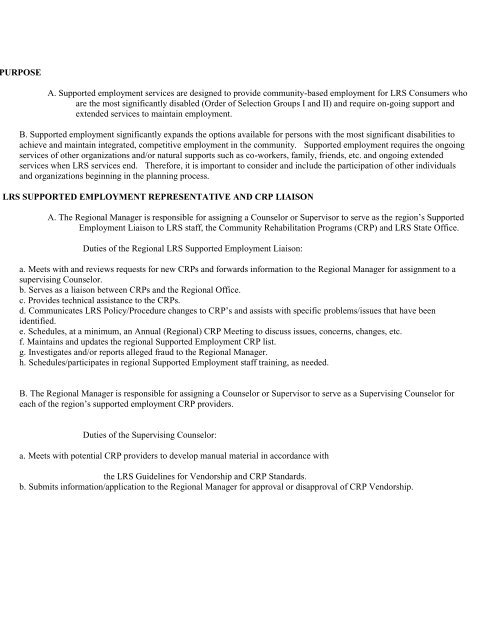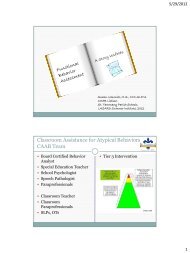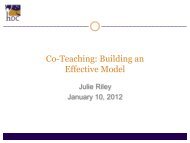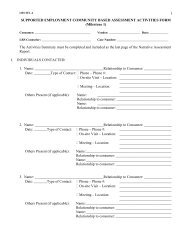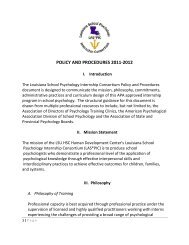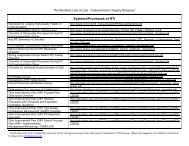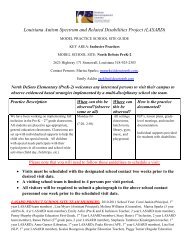I. PURPOSE A. Supported employment services are designed to ...
I. PURPOSE A. Supported employment services are designed to ...
I. PURPOSE A. Supported employment services are designed to ...
You also want an ePaper? Increase the reach of your titles
YUMPU automatically turns print PDFs into web optimized ePapers that Google loves.
URPOSEA. <strong>Supported</strong> <strong>employment</strong> <strong>services</strong> <strong>are</strong> <strong>designed</strong> <strong>to</strong> provide community-based <strong>employment</strong> for LRS Consumers who<strong>are</strong> the most significantly disabled (Order of Selection Groups I and II) and require on-going support andextended <strong>services</strong> <strong>to</strong> maintain <strong>employment</strong>.B. <strong>Supported</strong> <strong>employment</strong> significantly expands the options available for persons with the most significant disabilities <strong>to</strong>achieve and maintain integrated, competitive <strong>employment</strong> in the community. <strong>Supported</strong> <strong>employment</strong> requires the ongoing<strong>services</strong> of other organizations and/or natural supports such as co-workers, family, friends, etc. and ongoing extended<strong>services</strong> when LRS <strong>services</strong> end. Therefore, it is important <strong>to</strong> consider and include the participation of other individualsand organizations beginning in the planning process.LRS SUPPORTED EMPLOYMENT REPRESENTATIVE AND CRP LIAISONA. The Regional Manager is responsible for assigning a Counselor or Supervisor <strong>to</strong> serve as the region’s <strong>Supported</strong>Employment Liaison <strong>to</strong> LRS staff, the Community Rehabilitation Programs (CRP) and LRS State Office.Duties of the Regional LRS <strong>Supported</strong> Employment Liaison:a. Meets with and reviews requests for new CRPs and forwards information <strong>to</strong> the Regional Manager for assignment <strong>to</strong> asupervising Counselor.b. Serves as a liaison between CRPs and the Regional Office.c. Provides technical assistance <strong>to</strong> the CRPs.d. Communicates LRS Policy/Procedure changes <strong>to</strong> CRP’s and assists with specific problems/issues that have beenidentified.e. Schedules, at a minimum, an Annual (Regional) CRP Meeting <strong>to</strong> discuss issues, concerns, changes, etc.f. Maintains and updates the regional <strong>Supported</strong> Employment CRP list.g. Investigates and/or reports alleged fraud <strong>to</strong> the Regional Manager.h. Schedules/participates in regional <strong>Supported</strong> Employment staff training, as needed.B. The Regional Manager is responsible for assigning a Counselor or Supervisor <strong>to</strong> serve as a Supervising Counselor foreach of the region’s supported <strong>employment</strong> CRP providers.Duties of the Supervising Counselor:a. Meets with potential CRP providers <strong>to</strong> develop manual material in accordance withthe LRS Guidelines for Vendorship and CRP Standards.b. Submits information/application <strong>to</strong> the Regional Manager for approval or disapproval of CRP Vendorship.
c. Annually revises manual material in accordance with the LRS Guidelines for Vendorship and CRP Standards.
d. Reports changes <strong>to</strong> the Liaison so that the regional CRP list is up-<strong>to</strong>-date.. DEFINITIONS<strong>Supported</strong> Employmentloyment means competitive <strong>employment</strong> in an integrated work setting, or <strong>employment</strong> in an integrated work setting in whichindividuals <strong>are</strong> working <strong>to</strong>ward competitive <strong>employment</strong>, consistent with the strengths, resources, priorities, concerns,abilities, capabilities, interests, and informed choice of individuals with the most significant disabilities for whom:Competitive <strong>employment</strong> has not traditionally occurred, and/orand,Traditional competitive <strong>employment</strong> has been interrupted or intermittent as a result of the significant disability;<strong>Supported</strong> <strong>employment</strong> <strong>services</strong> <strong>are</strong> needed <strong>to</strong> obtain and maintain <strong>employment</strong> because of the nature and thesignificance of the disability; and,Extended (ongoing support) <strong>services</strong> <strong>are</strong> needed for the individual <strong>to</strong> maintain <strong>employment</strong> after the time-limited<strong>services</strong> from LRS have ended.2. <strong>Supported</strong> Employment also encompasses Transitional Employment Services for individuals with themost significant disabilities due <strong>to</strong> chronic mental illness (CMI). Transitional <strong>employment</strong> is aseries of temporary job placements in integrated work settings with ongoing supports, includingcontinuing sequential job placements, until job permanency is achieved. (Refer <strong>to</strong> Group Modelsfor <strong>Supported</strong> Employment Services in item VI of this section.Competitive EmploymentWork performed on a full-time or part-time basis in an integrated setting for which an individual is compensated a<strong>to</strong>r above the minimum wage, but not less than the cus<strong>to</strong>mary or usual wage paid by the employer forthe same or similar work performed by individuals who <strong>are</strong> not disabled.Integrated Work SettingJob sites in the community where most employees <strong>are</strong> not disabled and individuals with significant disabilitiesinteract on a regular basis with individuals without disabilities in performing their job duties. If anindividual with a significant disability is part of a distinct work group (mobile crew, enclave) thatconsists of only individuals with disabilities, the work group can consist of no more than eight (8)individuals, and the individuals in work group must have some interaction with individuals who <strong>are</strong>not disabled during their workday.
On-going Support ServicesThose <strong>services</strong> that <strong>are</strong> needed <strong>to</strong> support and maintain an individual with a most significant disability in supported<strong>employment</strong> based upon the rehabilitation needs of the individual identified in the Plan.Extended ServicesExtended <strong>services</strong> consists of on-going support <strong>services</strong> needed <strong>to</strong> support and maintain an individual with a mostsignificant disability in supported <strong>employment</strong> after time limited <strong>services</strong> <strong>are</strong> completed. Extended<strong>services</strong>:1. Must be coordinated and provided by an entity other than LRS (typically the supported <strong>employment</strong>vendor accessing the use of natural supports) when the time-limited <strong>services</strong> <strong>are</strong> completed; and,2. Must include at a minimum, twice monthly moni<strong>to</strong>ring at the work site of eachindividual in supported <strong>employment</strong> <strong>to</strong> assess <strong>employment</strong> stability unless the Plan provides foroff-site moni<strong>to</strong>ring as the best alternative needed <strong>to</strong> maintain <strong>employment</strong> stability.If off-site moni<strong>to</strong>ring is determined <strong>to</strong> be more appropriate, it must, at a minimum, consist of two meetings permonth with the individual and one contact per month with the employer.3. Can be provided from more than one source and can be natural supports such as employers, co-workers, family or friends.. ELIGIBILITY FOR SUPPORTED EMPLOYMENT SERVICES CRITERIAA. In order <strong>to</strong> receive supported <strong>employment</strong> <strong>services</strong> an individual must:1. Meet the eligibility requirements for vocational rehabilitation <strong>services</strong> as set forth in the LRS Vocational RehabilitationPolicy and the Technical Assistance and Guidance Manuals; and2. Meet the Agency’s Order of Selection criteria for the “most significantly disabled” (Category I or II) and,3. Meets the definition of <strong>Supported</strong> Employment as defined in this section in item III above.B. Additional, <strong>to</strong> assist the Counselor in determining the need for supported <strong>employment</strong> <strong>services</strong>, the counselor mustdocument that due <strong>to</strong> the severity of the disability, the Consumer:
• Has been unable <strong>to</strong> obtain and/or maintain competitive employed (without the assistance of extended follow – along<strong>services</strong>) for 4 or more quarters in a 3 year period’ or• Has had 4 or more jobs that lasted less than one month and must have experiencedat least 3 of the following in the last six months:Social withdrawalPoverty of speechPoor hygieneSymp<strong>to</strong>matic despite good medication and/or AT compliancePoor medication complianceDifficulty with initiating tasksDifficulty with following instructionDuring the last 2 years has experienced 3 or more events (e.g. hospitalization, incarceration or otherinstitutionalization, recurring health or mental health issues) which interrupted work or ability <strong>to</strong> live independentlyEligible for SSI or SSDI benefitsAny other significant limitations and/or circumstances/fac<strong>to</strong>rs that indicate aneed for ongoing and extended support.C. Counselor Responsibilities:1. Before referring the Consumer <strong>to</strong> a CRP for a <strong>Supported</strong> Employment Services the Counselor must determine and justifyin the case record, the Consumer’s eligibility and need for supported <strong>employment</strong> as defined above of this section.2. If the Consumer’s chosen CRP does not agree <strong>to</strong> serve the Consumer at the level of support for which he/she has beendetermined eligible, the CRP is not obligated <strong>to</strong> serve the individual (this includes CRP-initiated referrals); the Consumerwill be given the opportunity <strong>to</strong> choose another CRP that is willing <strong>to</strong> provide the service for which he/she has beendetermined eligible.. SUPPORTED EMPLOYMENT COMMUNITY-BASED ASSESSMENT AND NARRATIVE REPORT(Forms SE1 and SE1A)A. At any point during the eligibility process and prior <strong>to</strong> the development of the IPE the Counselor should authorize onForm RS-24 a <strong>Supported</strong> Employment Community-based Assessment. The assessment will assist the Consumer indetermining <strong>employment</strong> options that will identify a “good job match,” the types of support needed <strong>to</strong> obtain and maintain<strong>employment</strong> and other appropriate <strong>services</strong> that may be required for the consumer <strong>to</strong> maintain a supported <strong>employment</strong>placement.
1. The CRP must receive prior written authorization (Form RS-24) from the Counselorprior <strong>to</strong> providing the <strong>Supported</strong> Employment Community- based Assessment.2. Rate for the <strong>Supported</strong> Employment Community- based Assessment is $538**.B. It must be clear from the Narrative Report (Form SE1) and the AssessmentActivities Log (SE1A) that the <strong>Supported</strong> Employment Community-basedAssessment was performed in the community <strong>to</strong> assess the Consumer’s assets andneeds and that assessment information was gathered from activities conducted onmore than one occasion, from more than one source of information (i.e. family,friends, former employers, former teachers, etc) and in more than one location. TheNarrative Report must also include the completed Assessment Activities Form(SE1-A) completed by the CRP that provides documentation of the assessmentactivities.C. The Counselor must assure that the <strong>Supported</strong> Employment Community-basedAssessment and Narrative Report is completed thoroughly and addresses all <strong>to</strong>pic<strong>are</strong>as, as appropriate, as noted in the Guidelines for <strong>Supported</strong> EmploymentCommunity-based Assessment and Narrative Report Chart on the following page.
Evaluation ofextended followalong, <strong>to</strong> includeidentification ofthe naturalsupports andother long-termon-going supportpported Employment Community-based Assessment and Narrative Report (SE1) Guidelines ChartInterests(Preferences)Specific interests,such as working in anoffice, with children,in a bakery, workingwith animals, etc.Job interests, likesand dislikes.Interest in non-workrelated <strong>are</strong>as such ashobbies, routineduties at home, etc.Assets/Abilities(Contributions<strong>to</strong> Employment)Skills, or similarskills, talents &Personality traitsLearning styleand implicationsfor jobplacement.Strength andendurance.Routine dailyliving activities.Functionalapplication ofacademic skills(e.g. reading,moneymanagement,telling time,spelling) acrossall environments.Expressive &receptivecommunicationskills.PotentialTargeted JobTasksDescription ofwhat the personcan do on a jobsuch as typing,filing, sorting,etc and NOT jobtitles.Job Conditions(negotiable ornon-negotiable)Characteristicssuch astransportation;distance <strong>to</strong> work,work hours;accommodations;workenvironment;safety and typeof worksupervision.Available workincentives(SSI/SSDI,Medicaid, etc.).Relationship ofthe applicant’sskills <strong>to</strong> the localjob market.Possible use ofassistivetechnology/adaptations <strong>to</strong>accommodatedeficits.AnticipatedSupportNeeds(based on JobConditions/Preferences)Those necessary<strong>to</strong> maintain<strong>employment</strong>during training,job retention andlong term followalong such as:Mobility needs;Challengingbehavior; Effectsof medication onConsumer’sfunctioning;Description ofhome setting;Family/c<strong>are</strong> giverand supportneeds, includingsupport strategiesprovenbeneficial, andother concernsfor supportvoiced byConsumer and/orother.Need forpsychosocialsupports <strong>to</strong>promoteintegration;PotentialEmployersMust beIdentified byname or businesswithin thegeographicalboundaries andprioritizedaccording <strong>to</strong>Consumer’sneeds.Must be from avariety ofsources.Must identify the<strong>to</strong>p 3 choices.
D.Afterreceip<strong>to</strong>fthe<strong>Supported</strong>Employmentnt Report, and prior <strong>to</strong> the development of the IPE, a staffing must be held with the consumer, vendor, andLRS Counselor <strong>to</strong> determine an <strong>employment</strong> goal, anticipated <strong>services</strong> and dates, anticipated support needsand other <strong>services</strong> necessary <strong>to</strong> develop the IPE consistent with assessment results.When conducting a staffing with an individual with a significant disability that impairs theirjudgment and/or decision-making, the Counselor will make every effort <strong>to</strong> involve competent representativeson behalf of the Consumer (p<strong>are</strong>nt, guardian, friend, significant other, etc.) in the staffing process.E. Quality Indica<strong>to</strong>rs for <strong>Supported</strong> Employment Community-based Assessment and Narrative Report.1. The Assessment Report (SE1) and Assessment Activities Log (SE1A) was received *** and the six (6)<strong>to</strong>pic <strong>are</strong>as noted in the Guidelines for <strong>Supported</strong> Employment Community-based Assessment and NarrativeReport Chart noted above were addressed, <strong>to</strong> include, at a minimum, the following:The information was obtained from a variety of sources and at more than one location in thecommunity and documented on form SE1A.Accurate support needs and strategies were identified.Interests/assets/abilities in work and non-work <strong>are</strong>as were explored, identified and summarized in amanner suitable for marketing that individual <strong>to</strong> potential employers.Family, friends’, etc., concerns for Consumer supports and needs were identified.NOTE: If the Consumer has a significant disability that impairstheir judgment and/or decision-making, the report should reflectthat every effort was made <strong>to</strong> involve competent representativeson behalf of the Consumer (p<strong>are</strong>nt, guardian, friend, significan<strong>to</strong>ther, etc.) during the assessment process.The impact of job conditions/preferences was considered during job development and anticipatedsupport needs were identified.Potential targeted job tasks, i.e. <strong>employment</strong> goals were established.Targeted employers or industries were identified.Potential employers were listed and prioritized, and the <strong>to</strong>p 3 were indicated.The report is written in narrative form (no checklists) and provides a thorough and accurate“<strong>employment</strong> profile” of the Consumer.The Consumer and/or representative validated the accuracy of the assessment by their attendance,participation, and feedback in the staffing.Assessme
2. Ifthemmunity-based Assessment and Narrative Report is lacking critical or sufficient information as noted above<strong>to</strong> determine the <strong>employment</strong> goal or any other information necessary <strong>to</strong> develop the IPE, the Counselor mus<strong>to</strong>btain the information lacking in writing from the CRP before payment is authorized.CVI. oTHE INDIVIDUAL PLACEMENT MODEL FOR SUPPORTED EMPLOYMENT SERVICESuA. Individual n Placement Modelse A supported <strong>employment</strong> placement strategy in which an <strong>employment</strong> specialist assists the individuallwith competitive <strong>employment</strong> by matching the unique abilities of the individual withounmet employer needs. A job coach then provides training and support andrfacilitates the use of natural supports (on-site and off-site) and then gradually reducestime and assistance. Refer <strong>to</strong> Chapter 5 for the <strong>Supported</strong> Employment Forms (SE)dvendors <strong>are</strong> required <strong>to</strong> use.eB. <strong>Supported</strong> t Employment Miles<strong>to</strong>ne Outcome Payment Systemer 1. The Miles<strong>to</strong>ne Outcome Payment System is an outcome based payment system that allows for greaterm flexibility by CRPs by freeing them from hourly billing constraints and creates financial incentives byi encouraging the use of natural supports.ne A “Miles<strong>to</strong>ne Outcome” is defined as the completion of a “step” in the supported <strong>employment</strong> process ins assisting a Consumer <strong>to</strong> become competitively employed. The Miles<strong>to</strong>ne Outcome Steps <strong>are</strong> as follows:that<strong>Supported</strong>*Miles<strong>to</strong>ne 1 Job Development/Placement ServicesMiles<strong>to</strong>ne 2 One-Month Job Retention ServicesMiles<strong>to</strong>ne 3 Two-Month Job Retention ServicesMiles<strong>to</strong>ne 4 Three-Month Job Retention ServicesMiles<strong>to</strong>ne 5 Job Stabilization /Transition <strong>to</strong> Extended Follow-alongMiles<strong>to</strong>ne 6 Successful Case Closure **2 The CRP must receive prior written authorization (Plan and/or AWARE Draft Authorization) asappropriate) by the Counselor in order <strong>to</strong> provide the supported <strong>employment</strong> <strong>services</strong>.3. The CRP receives payment after the Counselor receives documentation that <strong>services</strong> were delivered andcompleted, as per the LRS <strong>Supported</strong> Employment Guidelines and Quality Indica<strong>to</strong>rs for each Miles<strong>to</strong>ne Stepas noted below in items VII thru X.EmploymentCo
4.Workbythethe span of each Miles<strong>to</strong>ne Step. If a Consumer loses a job, LRS will revert <strong>to</strong> the Miles<strong>to</strong>ne Step where theConsumer lost their job, and payment is authorized after the completion of that Miles<strong>to</strong>ne Step.For example, if the Consumer is at Miles<strong>to</strong>ne *2** (Two - Month Job Retention), and works for three weeksand then loses a job, payment would not be made for Miles<strong>to</strong>ne* 2**; until the Consumer completes one week of <strong>employment</strong> on a new job (three weeks of <strong>employment</strong> onthe first job plus one week of <strong>employment</strong> on the second job <strong>to</strong> equal a <strong>to</strong>tal of four weeks of <strong>employment</strong>, orthe achievement of Miles<strong>to</strong>ne *2**).NOTE: Additional fees for subsequent placements <strong>are</strong> not applicable in theMiles<strong>to</strong>ne Outcomes Payment System. When a Consumer loses a job and isplaced on another one, the CRP will only be eligible for payments resultingfrom the miles<strong>to</strong>nes the Consumer has not yet achieved, as noted above.ConsVII. uPLAN DEVELOPMENTmerisconsidered5. Each individual Miles<strong>to</strong>ne Outcome Payment Step can only be paid once <strong>to</strong> the CRP providing thesupported <strong>employment</strong> <strong>services</strong> <strong>to</strong> the Consumer, even if the Consumer loses a job after the completion of aMiles<strong>to</strong>ne Step and continues <strong>to</strong> receive <strong>services</strong> with that same CRP.The Plan and any amendment(s) <strong>are</strong> developed with the full participation of the Consumer and/orrepresentative and must be developed in accordance with the same guidelines as any other Plan forthe vocational rehabilitation program with the following additional requirements:A. The Plan must identify the <strong>employment</strong> field determined most appropriate by the LRS Counselor andConsumer, and the anticipated weekly work hours the Consumer will be employed. The <strong>employment</strong> goaland weekly work hours should be compatible with his/her maximum <strong>employment</strong> potential as a result ofthe disability. The intent of the supported <strong>employment</strong> program is for an individual with the most significantdisability <strong>to</strong> work <strong>to</strong>ward competitive <strong>employment</strong>; therefore, beginning at Job Stabilization/Transition <strong>to</strong>Extended Services, the Consumer must be working <strong>to</strong> their maximum potential and earning at least minimumwage.B. The Counselor must list the Miles<strong>to</strong>nes and/or any other <strong>services</strong> LRS will purchase/provide. Purchasedsupported <strong>employment</strong> <strong>services</strong> (Miles<strong>to</strong>nes) on the Plan must be obtained through an approved <strong>Supported</strong>Employment CRP and generally cannot exceed 18 months. If a Consumer requires longer than 18 months inreaching job stabilization, the LRS Counselor can extend the service in accordance with Plan guidelines.cumulativeC. The Counselor must identify the anticipated plan for extended <strong>services</strong> (as documented in writing by theCRP on form SE3) on the Plan and must include the following:during
ng and/or coordinating the access of natural supports) for the initial on-going <strong>services</strong> and the extendedfollow-along <strong>services</strong> when the time-limited <strong>services</strong> provided by LRS <strong>are</strong> completed.ThD. *MILESTONE e1 - Job Development and Placement Services **name(s)oftheentity(typicallytheCRP1. The purpose of job development and placement <strong>services</strong> is <strong>to</strong> develop a successful job match for theConsumer. Job development requires the <strong>employment</strong> specialist make contact with prospective employers <strong>to</strong>determine if they have needs that match the results of the <strong>Supported</strong> Employment Community-basedAssessment and <strong>employment</strong> goal on the Plan, and <strong>to</strong> facilitate the hiring of the Consumer if it is a goodmatch.2. Quality Indica<strong>to</strong>rs for Job Development and Placement Services (Miles<strong>to</strong>ne 1):a. Job Development - When job development begins, the CRP submits the Monthly Job DevelopmentProgress Report (Form SE2) <strong>to</strong> the Counselor, which must document that the following Quality Indica<strong>to</strong>rs forJob Development Services were met:Dates and names of employer contacts (contacts must reflect results of the community-basedassessment and narrative report.Results of the <strong>to</strong>p 3 employer contacts as identified in the Assessment.Names and dates of any other individuals contacted and the results of those contacts.Names and dates of Consumer contacts and resultsb. Job Placement- the Job Match Analysis (Form SE2-A) and the Natural Supports Plan (Form SE2-B) mustbe completed by the CRP <strong>to</strong> assure it is a good job match. In order <strong>to</strong> assure that the all Quality Indica<strong>to</strong>rs forJob Placement Services <strong>are</strong> met, the Job Match Analysis must describe the following:Name and address of employerEmployment goalAnticipated date of <strong>employment</strong>Rate of pay and benefitsJob duties consistent with the Consumer’s interests, assets, abilities, conditions, preferences andanticipated support needsJob tasks the Consumer can performEssential and episodic work dutiesEmployer’s need/concern for quality and productivitySkills and traits desired by employerPhysical demands/support needsEnvironmental demands/supports needsWork cultureprovidi
Typicalinitialandongoing<strong>employment</strong>training
Strategiesforon/offsite
TheCRPandConsumerored the Job Match Analysis Report.c. Before the Counselor authorizes payment for Job Development and Placement Services, Miles<strong>to</strong>ne 1, theCounselor must:Review the Job Match Analysis Report and verify that the placement is a good job match based uponthe results of the Assessment and meets all of the Quality Indica<strong>to</strong>rs for Job Development/Placement Servicesas noted above.Verify that Consumer is in agreement with the CRP’s Job Match Analysis Report and the job bycontacting the Consumer and/or the Consumer’s representative and documenting such contact in the caserecord.Verify that the Consumer had been employed at least one day.d. The Counselor must resolve any discrepancies in the Job Match Analysis before the Job Development andPlacement Services Miles<strong>to</strong>ne Outcome payment is authorized.E. *MILESTONES 2, 3, and 4 – Job Retention Services**1. The purpose of this service is <strong>to</strong> provide the job coach training and supports needs both on and off thework site that <strong>are</strong> necessary that will assist the Consumer in adjusting <strong>to</strong> the demands of the job leading <strong>to</strong>successful job stabilization.Consumer’srepresentative2. At a minimum, the Counselor must:• Review the monthly progress reports from the CRP (Form SE3) and document the Consumer’s progress inthe case record and any action taken; and,• At a minimum, maintain quarterly contact with the Consumer and complete the following:Assure that the appropriate training supports needs <strong>are</strong> in place;Assess the Consumer’s progress in supported <strong>employment</strong>;Provide vocational guidance and counseling as appropriate; and,Document in the case record the guidance and counseling provided.3. Before the Counselor can authorize payment for the Job Retention Miles<strong>to</strong>nes *2, 3 and 4** Outcome, theCounselor must ensure that the CRP met the Quality Indica<strong>to</strong>rs for Job Retention Services. The MonthlyProgress Report (SE3) must document the following:. Progress made by Consumer. Identification of any problemssign
.Supportsprovidedwereconsistentwiththeplan
.Modificationsweremadewhensupportneedschanged
.Naturallywere used <strong>to</strong> the extent possible and in cooperation with the employer.occurringtraining,supervision,andsupports
.Consumer/Familyis/<strong>are</strong>satisfiedwiththejob.
.Consultationand/orsupportswereprovided
.Numbersofhoursworked
.Wagesearnedandverifiedbycheckstubsorotherdocumentation from employer
.Consumer/FamilyinformedofSSI/SSDIbenefitplanning, if applicable.
.ThatConsumersigned the Progress Form (SE3) <strong>to</strong> verify the provision of supports and agrees with the monthly progress.4. The Counselor must resolve any discrepancies in CRP reporting before payment for the Job RetentionMiles<strong>to</strong>ne(s) is authorized.F. *MILESTONE t5 - Job Stabilization /Transition <strong>to</strong> Extended Services/Employed Status **he 1. The Job Stabilization or transition <strong>to</strong> extended <strong>services</strong> involves the successful transition from intensiveon-going support <strong>services</strong> <strong>to</strong> transition <strong>to</strong> extended <strong>services</strong>. The purpose of this phase is <strong>to</strong> transition theConsumer <strong>to</strong> a maintenance level of support. The counselor must document in the case record the date JobStabilization occurs.2. At a minimum, the Counselor must:• Review the monthly progress reports from the CRP (Form SE3) and document the Consumer’s progress inthe case record and any action taken by the Counselor; and,• At a minimum, maintain quarterly contact with the Consumer <strong>to</strong> complete the following:(ortheConsumer’sAssure that the appropriate training and supports needs <strong>are</strong> in place;Assess the Consumer’s progress in supported <strong>employment</strong>;Provide vocational guidance and counseling as appropriate; and,Document in the case record the guidance and counseling provided.3. Before the Counselor can authorize payment for the Job Stabilization Miles<strong>to</strong>ne *5**Outcome, the Counselor must ensure that the CRP met the Quality Indica<strong>to</strong>rs forJob Stabilization. The Monthly Progress Report Form (SE3) must document thefollowing:. Progress made by Consumer. Identification of any problems. Supports provided were consistent with the plan. Modifications were made when support needs changed. Naturally occurring training, supervision, and supports were used. Consumer/Family is/<strong>are</strong> satisfied with the job.representative)
.Consultationand/orsupportswereprovided
.Numbersofhoursworked(AtthisMiles<strong>to</strong>ne,theConsumer must now be working at his or her maximum level of potential).
.Wagesearnedandverifiedbycheckstubsorotherdocumentation from employer
.Consumer/FamilyinformedofSSI/SSDIbenefitplanning, if applicable.
.ThattheConsumer(ortheConsumer’srepresentative)signed the Progress Form (SE3) <strong>to</strong> verify the provision of supports and agrees with the monthly progress
.MustawrittenplanfromtheCRPfortheongoing extended support <strong>services</strong> that will be provided (this is not required for on-site training <strong>services</strong>). TheMonthly Job Retention Progress Form SE3 can be used <strong>to</strong> document the plan for extended supports4. The Counselor must resolve any discrepancies in CRP reporting before payment for the Job StabilizationMiles<strong>to</strong>ne is authorized.i*G. nMILESTONE 6 - Successful Case Closure/Closed-Rehabilitated**clude1. The same basic considerations apply when closing the Consumer’s case as “rehabilitated” in supported<strong>employment</strong> as for any other type of <strong>employment</strong>, except for the need <strong>to</strong> specify and ensure thatextended/ongoing <strong>services</strong> <strong>are</strong> in place and <strong>are</strong> provided without interruption. Prior <strong>to</strong> closing a case as“rehabilitated” in supported <strong>employment</strong>, the Counselor must document the following Indica<strong>to</strong>rs in the caserecord:a. The Consumer has maintained a supported <strong>employment</strong> placement for at least 90days of consecutive competitive <strong>employment</strong> after making the transition <strong>to</strong>extended <strong>services</strong> (determined from the case record documentation of the dateof transition <strong>to</strong> extended <strong>services</strong>), andb. The Consumer is working at his/her maximum level of <strong>employment</strong> as a result ofthe disability and is earning at least minimum wage; andc. Extended <strong>services</strong> <strong>are</strong> effectively in place, and <strong>are</strong> documented in the case record.2. At case closure, the Counselor must also document the following in the case record:a. Verification of continued <strong>employment</strong> through contact with the Consumer or his/her representative; andb. Verification of wages by obtaining a copy of the Consumer’s check stub(s) or other suitable documentationfrom the employer (on company letterhead) of the hours worked wages, and withholdings.3. After the final payment <strong>to</strong> the vendor has been authorized and processed, the case record is moved fromService Status <strong>to</strong> Employed Status and Closed-Rehabilitated Status.
Ready Reference Chart<strong>Supported</strong> Employment Miles<strong>to</strong>ne System for Individual Placement Model: Total: *$6188**Interests(Preferences)Specific interests,such as working in anoffice, with children,in a bakery, workingwith animals, etc.Job interests, likesand dislikes.Interest in non-workrelated <strong>are</strong>as such ashobbies, routineduties at home, etc.Assets/Abilities(Contributions<strong>to</strong> Employment)Skills, or similarskills, talents &Personality traitsLearning styleand implicationsfor jobplacement.Strength andendurance.Routine dailyliving activities.Functionalapplication ofacademic skills(e.g. reading,moneymanagement,telling time,spelling) acrossall environments.Expressive &receptivecommunicationskills.PotentialTargeted JobTasksDescription ofwhat the personcan do on a jobsuch as typing,filing, sorting,etc and NOT jobtitles.Job Conditions(negotiable ornon-negotiable)Characteristicssuch astransportation;distance <strong>to</strong> work,work hours;accommodations;workenvironment;safety and typeof worksupervision.Available workincentives(SSI/SSDI,Medicaid, etc.).Relationship ofthe applicant’sskills <strong>to</strong> the localjob market.Possible use ofassistivetechnology/adaptations <strong>to</strong>accommodatedeficits.AnticipatedSupportNeeds(based on JobConditions/Preferences)Those necessary<strong>to</strong> maintain<strong>employment</strong>during training,job retention andlong term followalong such as:Mobility needs;Challengingbehavior; Effectsof medication onConsumer’sfunctioning;Description ofhome setting;Family/c<strong>are</strong> giverand supportneeds, includingsupport strategiesprovenbeneficial, andother concernsfor supportvoiced byConsumer and/orother.Need forpsychosocialsupports <strong>to</strong>promoteintegration;PotentialEmployersMust beIdentified byname or businesswithin thegeographicalboundaries andprioritizedaccording <strong>to</strong>Consumer’sneeds.Must be from avariety ofsources.Must identify the<strong>to</strong>p 3 choices.Evaluation ofextended followalong, <strong>to</strong> includeidentification ofthe naturalsupports andother long-termon-going support<strong>services</strong>.NOTE: CRP must complete the jobanalysis prior <strong>to</strong> <strong>employment</strong>
II.GROUPMODELSFORSUPPORTEDEMPLOYMENTSERVICES:A. The <strong>Supported</strong> Employment Steps and/or <strong>services</strong> that can be provided by a CRP offering a GroupModel <strong>employment</strong> setting include:. Community-based <strong>Supported</strong> Employment Assessment and Narrative Report(Forms SE1 and SE1-A)Job Development and Placement Services (Forms SE2, SE2A & SE2B)Job Retention Services (Form SE3)Job Stabilization/Transition <strong>to</strong> Extended Services (Form SE3)Successful Case Closure (SE3)B. A Group Model <strong>employment</strong> setting must comply with the definitions for supported<strong>employment</strong> as outlined in Section 412.14, and includes: integrated setting, competitive work,commensurate wages, and on-going and extended support <strong>services</strong>.C. There <strong>are</strong> (3) three different Group Models under <strong>Supported</strong> Employment defined below and <strong>are</strong> theEnclave Model, the Mobile Work Crew Model, and the Transitional Employment Model for the ChronicallyMentally Ill (CMI).1. Enclave Model: An <strong>employment</strong> situation in competitive <strong>employment</strong> in which a group of eight (8) orfewer workers with disabilities <strong>are</strong> working at a particular work setting. The disabled workers may bedisbursed throughout the company among non-disabled workers or congregated as a group in one part of thebusiness.a. The supervisor for the enclave is responsible for securing work assignments for the enclave from theemployer, organizing the work <strong>to</strong> help enable job performance, training and supervising employees,managing workflow, and supporting the integration of enclave employees with other company employees.b. Payment is for five (5) months at $500 per month.2. Mobile Work Crew: A group of eight (8) or fewer workers with disabilities who perform work in avariety of locations under the supervision of a job coach who supervises the crew. These locations must be inan integrated setting.a. The mobile crew should provide the workers with enough jobs that they havepreviously mastered in order <strong>to</strong> maximize wages and productivity, increasethe likelihood of individual choice in job selection and <strong>to</strong> have workerscontinue <strong>to</strong> learn new jobs that will increase their marketable skills.b. Payment is for five (5) months at $500 per month.
3.TransitionalEmploymentModelforChronic Mental Illness (CMI): A series of <strong>employment</strong> opportunities <strong>designed</strong> <strong>to</strong> prep<strong>are</strong> individuals withchronic mental illness for permanent <strong>employment</strong>.a. Transitional <strong>employment</strong> is a type of supported <strong>employment</strong> that is a series of time limited positions inintegrated settings. On-going support <strong>services</strong>, including sequential job placement, <strong>are</strong> provided in order <strong>to</strong>gain confidence, interpersonal skills, and job references needed <strong>to</strong> secure and maintain integrated<strong>employment</strong> that matches the consumer’s interest and capabilities.b. The Transitional Employment Program may be the best service option for an individual with CMI who is:. Uncertain about choosing an appropriate vocational goal. Fearful or tentative about his or her abilities <strong>to</strong> maintain <strong>employment</strong> and/or. An individual for whom traditional work adjustment <strong>services</strong> would have been considered the bestpre-<strong>employment</strong> preparation service.c. Payment is $500 for Each Transitional Placement and is limited <strong>to</strong> a maximum of three (3) placements.D. The Community-based <strong>Supported</strong> Employment Assessment and Narrative Report*All Group Models for supported <strong>employment</strong> <strong>services</strong> follow the <strong>Supported</strong> EmploymentCommunity-based Assessment and Narrative Report (forms SE1 and SE1A) as explained in item V.above.**Payment is $538 for the Community-based Assessment.**E. Plan DevelopmentThe Plan and any amendment(s) <strong>are</strong> developed with the full participation of the consumer and/orrepresentative and must be developed in accordance with the same guidelines as any other Plan forthe vocational rehabilitation program and must include the additional requirements as set forth underPlan Development above.F. Counselors Responsibilities1. Before referring the consumer <strong>to</strong> a CRP for Group Model <strong>employment</strong> <strong>services</strong>, the Counselor mustdetermine and justify in the case record, the consumer’s eligibility and need for supported <strong>employment</strong>.Individualswith
2.TheCRPmustIX. POST-EMPLOYMENT SERVICESreceivepriorauthorizationbythe Counselor in order <strong>to</strong> provide any supported <strong>employment</strong> <strong>services</strong> under a Group Model.3. At a minimum, the Counselor must:a. Review the monthly progress reports from the CRP (Form SE3) and document the consumer’s progress inthe case record; and,b. Maintain periodic communication with both the CRP and the consumer <strong>to</strong> assure that the appropriatetraining and supports needs <strong>are</strong> in place, and <strong>to</strong> assess the consumer’s progress <strong>to</strong>wards achieving a successfuloutcome; and,c. Meet at least quarterly with the consumer <strong>to</strong> assure that the appropriate training and supports needs <strong>are</strong> inplace; assess the consumer’s progress in supported <strong>employment</strong>; provide vocational guidance and counseling;and document in the case record the guidance and counseling provided.For Individual and Group Models for <strong>Supported</strong> Employment ServicesA. The Counselor can provide post-<strong>employment</strong> <strong>services</strong> (refer <strong>to</strong> Part 416 of the Technical Assistance andGuidance Manual) for individuals in supported <strong>employment</strong> if such <strong>services</strong> <strong>are</strong> necessary <strong>to</strong> maintain theConsumer's job placement that <strong>are</strong> not provided as ongoing extended <strong>services</strong> Examples include:. Maintenance of assistive technology;. Job station re-design; and,. Replacement of an assistive technology device(s).B. If the scope of the <strong>services</strong> extends beyond short-term <strong>services</strong> <strong>to</strong> assist the Consumer inmaintaining the initial job, the Counselor should not provide those <strong>services</strong> aspost-<strong>employment</strong> <strong>services</strong>.wX. REGIONAL rMONITORING FOR SUPPORTED EMPLOYMENT SERVICESit A. If the Counselor discovers discrepancies in CRP reporting/invoicing, the Counselor cannot authorizet payment and will take the following steps:en1. The Counselor will immediately notify their Supervisor of any discrepancies noted in CRPreporting/invoicing. The Counselor will then proceed <strong>to</strong> resolve the discrepancy with the CRP. If thediscrepancy is resolved, the Counselor can authorize payment.1. If the Counselor is unable <strong>to</strong> resolve the discrepancy with the CRP, the Counselor will advise theSupervisor and/or Regional Manager
1.TheSupervisororcontacttheCRP and the Consumer, or the Consumer’s representative (the employer may be contacted if necessary),<strong>to</strong> further investigate, and attempt <strong>to</strong> resolve the discrepancy. If the discrepancy is resolved, theCounselor can authorize payment.1. If the discrepancy cannot be resolved, the Regional Manager will contact the program manager forsupported <strong>employment</strong> in state office, who will further investigate the situation <strong>to</strong> determine whether thediscrepancy can be resolved or whether additional action is required.XI. PURCHASING GUIDELINES FOR SUPPORTED EMPLOYMENTA. <strong>Supported</strong> Employment <strong>services</strong> <strong>are</strong> not dependent upon the Consumer’s participation in the cost of such<strong>services</strong>. However, maintenance, transportation, and any other ancillary service of this type is subject <strong>to</strong>both the Consumer’s ability <strong>to</strong> participate in the cost of such <strong>services</strong> and the exploration and use ofcomparable <strong>services</strong> and benefits.B. The Counselor must refer <strong>to</strong> Chapter 5 of the Technical Assistance and Guidance Manual or theReady Reference Chart listed above <strong>to</strong> determine the appropriate supportedR<strong>employment</strong> service rates.egC. LRS will not fund Extended Ongoing Support Services.ionD. The Counselor must complete the IPE or Plan and the RCA will complete the AWARE DraftaAuthorization for purchased supported <strong>employment</strong> <strong>services</strong>. This information is submitted <strong>to</strong> thelSupervisor for approval.MaE. If any single item/service on an IPE or Plan is equal <strong>to</strong> or greater than $10,000, the IPE or Plan shall benconsidered “high cost”. In these instances, the Counselor must have both the IPE or Plan and the AWAREaDraft Authorization approved by both the Supervisor and the Regional Manager.gerF. If the <strong>to</strong>tal of all items/<strong>services</strong> on any IPE or Plan is equal <strong>to</strong> or greater than $20,000, theIPE or Plan shall be considered “high cost”. In these instances, the Counselor must have both thew IPE or Plan and the AWARE Draft Authorization approved by both the Supervisor and the Regionali Manager.ll


